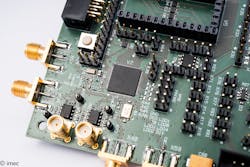It’s no secret that connecting sensors inside factory equipment and smart household devices takes a special breed of wireless network. For years, chipmakers like Semtech and Silicon Labs have known how these networks should act: spanning wide areas and draining little power from the tiny batteries inside devices.
But word has spread quickly. Industrial giants, including General Electric and Honeywell, are making software to collect data from factory sensors, and device makers are selling smart household devices. As a result, low-power networks are growing in demand and the number of options is increasing rapidly. Many chipmakers have begun clamoring for standard to be developed.
Imec, an electronics research center in Belgium, is trying to cut through all the competing technologies. It recently announced a new radio chip that handles multiple low-power wireless standards, enabling it to connect devices that might have been isolated on a single type of network. It was developed with the Holst Centre in the Netherlands, a research laboratory for sensors and flexible electronics.
The new chip contains hardware for more than five different low-power wide area networks, including the popular LoRa and Sigfox protocols, which are based on rival technologies. The radio also handles IEEE 802.15.4 protocols like ZigBee and Thread, which Google's Nest division has used to connect its thermostats and security cameras.
The system is also compatible with cellular networks, which under normal circumstances chew through too much power and bandwidth for tiny electronic devices. For example, motion sensors in a parking garage that monitor how many spots are taken might need to operate for years on end without a battery change – and any smartphone user knows that 4G eats through battery fast.
The 3G Partnership Project, an industry group that maintains cellular standards, is in the process of making a low-power cellular protocol known as Narrowband-IoT. It is being designed to share the airwaves with LTE signals, while supporting very low data rates and power consumption.
The imec chip was introduced as low-power networks are increasingly being used to connect devices inside factories, buildings, and city infrastructure. For example, they can connect motion sensors in an office building with a main control system, which automatically turns off the lights and air conditioning in empty rooms. In certain cases, low-power networks are even being used for monitoring the environment — even to help track volcano activity in Japan.
“It is clear that protocols such as NB-IoT, SigFox, and LoRA are here to stay for the coming years,” said Kathleen Philips, the program director for perceptive systems at imec, who revealed the chip at the laboratory’s technology forum in Belgium.
What remains unclear is which standards will survive the early years of the Internet of Things, which companies are still having trouble to define. In factories and buildings, automated systems that incorporate vast arrays of sensors are still in the early stages of development, and most companies are not rallying behind a single networking protocol.
The new radio is a highly integrated system, including an RF front end, ARM processor, and SRAM memory. Operating in the industrial, scientific, medical (ISM) and short-range devices (SRD) bands, it covers a frequency range between 780MHz to 930MHz, which has been reserved for special applications outside telecommunications.
The chip was developed as part of the Imec Industrial Affiliation program, which it established last year along with the Holst Centre. The program aims to combine small, low-power sensors and wireless chips into the same package. That allows the chips to easily connect with each other and the cloud, where most of the sensor data will be stored and analyzed.
About the Author
James Morra
Senior Editor
James Morra is the senior editor for Electronic Design, covering the semiconductor industry and new technology trends, with a focus on power electronics and power management. He also reports on the business behind electrical engineering, including the electronics supply chain. He joined Electronic Design in 2015 and is based in Chicago, Illinois.

